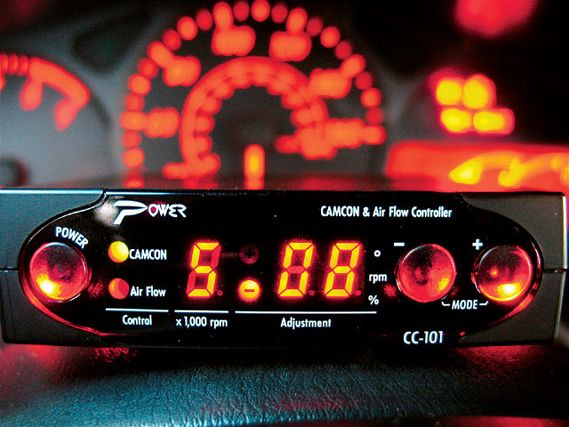 | 2001 Toyota Celica GT-S - Power Enterprise Camcon & Air Flow Controller
| 2001 Toyota Celica GT-S - Power Enterprise Camcon & Air Flow Controller
It might sound like the Camcon got its name from a futuristic sci-fi flick, but this product has nothing to do with hostile planets or epic battles. So what does it do, then? It's the first affordable non-standalone control unit for Toyota and Honda's variable valve timing systems. It works with both VVTi and VTEC systems by allowing users to easily adjust timing, air/fuel ratios and cam crossover points. And you thought the Toyota and Honda camps couldn't reconcile their differences.
Our test bed is a bone-stock (with the exception of a Power Enterprise Air Impulse II intake system) 2001 Toyota Celica GT-S running on 91-octane gas. Strapped down on XS Engineering's Dynojet dynamometer and fitted with a highly recommended wideband air/fuel ratio meter, such as the unit by NTK, the GT-S laid down a baseline run of 143.6 hp and 107.2 lb-ft of torque. Our tester ran surprisingly rich, with air/fuel ratios right around 10.8:1.
The compact Camcon unit has a simple three-button layout featuring a digital display. About as large as the average turbo timer, it can fit into any number of locations in the dash. The Camcon gives you the flexibility to adjust cam phasing by +/- 20 degrees in 500-rpm increments or VTEC crossover points in 100-rpm increments. Air flow can be leaned out by as much as 10 percent and richened by as much as 20 percent in 500-rpm increments.
It's important to understand how each valve timing system works. VTEC (variable valve timing and lift electronic control) uses camshafts with two sets of lobes. At the specified crossover point, the VTEC solenoid switches the cam from a primary low-lift (how far a valve opens) short-duration (how long a valve opens) lobe to a secondary high-lift long-duration lobe. While VTEC has two cam profiles, VVTi maintains the same cam profile and alters only when the valves open and close in relation to ignition timing. Also, instead of a mechanical system VVTi uses hydraulics.
Keep in mind Toyota's stock computer already has a cam phasing program, which isn't initially set to zero degrees; we're just making changes relative to the stock program. After the baseline run, we changed the cam timing to -15 degrees throughout the powerband, knowing we would lose horsepower but prove a point. From 3000 to 5200 rpm as much as 7 hp were lost; slight gains were seen in the 5300 to 6300 rpm range, but a monstrous 20 hp were lost toward red line. We progressively tested cam phasing at -10, -5, +5, +10 and +15 degrees, noting where power was gained and lost.
Then, we began to test different combinations of cam phasing at different rpm ranges. If there is a large or radical change in cam phase between any given rpm, the Camcon will make that transition smoothly instead of suddenly. For example, when you set the cam phasing to change from -5 to +8 degrees in a certain rpm range, it will transition gradually so you don't end up with irregular spikes or rough spots.
On our first attempt to adjust the Camcon's air flow setting along with cam timing, we changed the settings to +3 degrees cam timing for zero to 4500 rpm, -8 degrees timing and -1 percent air flow from 5000 to 6000 rpm, +5 degrees timing and +1 percent air flow from 6500 to 7500 rpm, and -5 degrees timing and -5 percent air flow from 8000 to red line. Until 5000 rpm the power curve almost mirrored the baseline; from 5000 to 6300 rpm as much as 5 hp was gained, while 2- to 3-hp gains were seen from 6300 rpm with a jump of 17 hp at red line. We saw peak power gains of 8.8 hp and 1.4 lb-ft of torque.
After 16 dynos of trial and error, we were ready to make the final settings. We saw a minimum of 9 hp gains throughout, with additional gains of 5 hp and 12 lb-ft of torque from 3000 to 4600 rpm, 10 hp and 10 lb-ft of torque in the 4600 to 6300 rpm range and 16 hp and 13 lb-ft of torque from 6300 rpm to red line.
What were our settings for the final gains? Don't worry we wouldn't leave you in the dark. We kept all of the previous settings except for the air flow settings, which we changed to -5 percent from 5000 rpm to red line. From our baseline run of 143.6 hp and 107.2 lb-ft of torque, we ended up with 157.7 hp and 116.3 lb-ft of torque, an increase of 14.1 hp and 9.1 lb-ft of torque.
The Camcon answers the call of Toyota tuners without forgetting the Honda faithful. Power gains in our test were quite substantial, and when you start adding more parts in the search of horsepower, the Camcon becomes an even more valuable tuning tool. For a MSRP of $419, push grandma out of the way to get Power Enterprises' latest and greatest.
